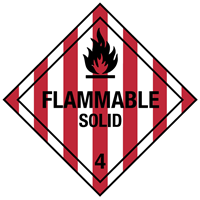
 Print
Print
Chemical Datasheet
TITANIUM POWDER, WETTED WITH NOT LESS THAN 25% WATER |

|
Chemical Identifiers
| CAS Number |
UN/NA Number |
DOT Hazard Label |
USCG CHRIS Code |
|
|
|
|
none
|
| NIOSH Pocket Guide |
International Chem Safety Card |
|
none
|
none
|
NFPA 704
data unavailable
General Description
A gray lustrous sludge. Easily ignited when dry. Very finely powdered material may be ignited by sparks.
Hazards
Reactivity Alerts
- Highly Flammable
- Strong Reducing Agent
- Known Catalytic Activity
Air & Water Reactions
Highly flammable Pyrophoric in dust form [Bretherick 1979, p. 104]. Titanium is water-reactive at 700C, releasing hydrogen, which may cause an explosion [Subref: Mellor, 1941, vol. 7, 19].
Fire Hazard
Excerpt from ERG Guide 170 [Metals (Powders, Dusts, Shavings, Borings, Turnings, or Cuttings, etc.)]:
May react violently or explosively on contact with water. Some are transported in flammable liquids. May be ignited by friction, heat, sparks or flames. Some of these materials will burn with intense heat. Dusts or fumes may form explosive mixtures in air. Containers may explode when heated. May re-ignite after fire is extinguished. (ERG, 2024)
Health Hazard
Excerpt from ERG Guide 170 [Metals (Powders, Dusts, Shavings, Borings, Turnings, or Cuttings, etc.)]:
Oxides from metallic fires are a severe health hazard. Inhalation or contact with substance or decomposition products may cause severe injury or death. Fire may produce irritating, corrosive and/or toxic gases. Runoff from fire control or dilution water may cause environmental contamination. (ERG, 2024)
Reactivity Profile
TITANIUM is a reducing agent. Powdering increases its reactivity. Wetting reduces the reactivity of the powder. Titanium reacts violently with cupric oxide and lead oxide when heated. When titanium is heated with potassium chlorate, potassium nitrate, or potassium permanganate, an explosion occurs [Mellor 7:20. 1946-47]. The residue from the reaction of titanium with red fuming nitric acid exploded violently when the flask was touched [Allison 1969]. Liquid oxygen gives a detonable mixture when combined with powdered titanium, [Kirchenbaum 1956].
Belongs to the Following Reactive Group(s)
- Metals, Elemental and Powder, Active
- Water and Aqueous Solutions
Potentially Incompatible Absorbents
No information available.
Response Recommendations
Isolation and Evacuation
Excerpt from ERG Guide 170 [Metals (Powders, Dusts, Shavings, Borings, Turnings, or Cuttings, etc.)]:
IMMEDIATE PRECAUTIONARY MEASURE: Isolate spill or leak area in all directions for at least 50 meters (150 feet) for liquids and at least 25 meters (75 feet) for solids.
LARGE SPILL: Consider initial downwind evacuation for at least 50 meters (160 feet).
FIRE: If tank, rail tank car or highway tank is involved in a fire, ISOLATE for 800 meters (1/2 mile) in all directions; also, consider initial evacuation for 800 meters (1/2 mile) in all directions. (ERG, 2024)
Firefighting
Excerpt from ERG Guide 170 [Metals (Powders, Dusts, Shavings, Borings, Turnings, or Cuttings, etc.)]:
DO NOT USE WATER, FOAM OR CO2. Dousing metallic fires with water will generate hydrogen gas, an extremely dangerous explosion hazard, particularly if fire is in a confined environment (i.e., building, cargo hold, etc.). Use DRY sand, graphite powder, dry sodium chloride-based extinguishers, or class D extinguishers. Confining and smothering metal fires is preferable rather than applying water. If it can be done safely, move undamaged containers away from the area around the fire.
FIRE INVOLVING TANKS, RAIL TANK CARS OR HIGHWAY TANKS: If impossible to extinguish, protect surroundings and allow fire to burn itself out. (ERG, 2024)
Non-Fire Response
Excerpt from ERG Guide 170 [Metals (Powders, Dusts, Shavings, Borings, Turnings, or Cuttings, etc.)]:
ELIMINATE all ignition sources (no smoking, flares, sparks or flames) from immediate area. Do not touch or walk through spilled material. Stop leak if you can do it without risk. Prevent entry into waterways, sewers, basements or confined areas. (ERG, 2024)
Protective Clothing
Excerpt from ERG Guide 170 [Metals (Powders, Dusts, Shavings, Borings, Turnings, or Cuttings, etc.)]:
Wear positive pressure self-contained breathing apparatus (SCBA). Structural firefighters' protective clothing provides thermal protection but only limited chemical protection. (ERG, 2024)
DuPont Tychem® Suit Fabrics
No information available.
First Aid
Excerpt from ERG Guide 170 [Metals (Powders, Dusts, Shavings, Borings, Turnings, or Cuttings, etc.)]:
Refer to the "General First Aid" section. (ERG, 2024)
Physical Properties
Flash Point: data unavailable
Lower Explosive Limit (LEL): data unavailable
Upper Explosive Limit (UEL): data unavailable
Autoignition Temperature: data unavailable
Melting Point: data unavailable
Vapor Pressure: data unavailable
Vapor Density (Relative to Air): data unavailable
Specific Gravity: data unavailable
Boiling Point: data unavailable
Molecular Weight: data unavailable
Water Solubility: data unavailable
Ionization Energy/Potential: data unavailable
IDLH: data unavailable
AEGLs (Acute Exposure Guideline Levels)
No AEGL information available.
ERPGs (Emergency Response Planning Guidelines)
No ERPG information available.
PACs (Protective Action Criteria)
| Chemical |
PAC-1 |
PAC-2 |
PAC-3 |
| Titanium (7440-32-6)
|
30 mg/m3 |
330 mg/m3 |
2000 mg/m3 |
(DOE, 2024)
Regulatory Information
EPA Consolidated List of Lists
No regulatory information available.
CISA Chemical Facility Anti-Terrorism Standards (CFATS)
No regulatory information available.
OSHA Process Safety Management (PSM) Standard List
No regulatory information available.
Alternate Chemical Names
- ALPASTE RTA 030
- C.P. TITANIUM
- DENTCRAFT TITAN INGOT
- ELGARD 210
- M 350
- M 350 (METAL)
- SMELLOFF-CUTTER TITANIUM
- TG-TV
- TIMET 115
- TITANIUM ELEMENT
- TITANIUM FULLERIDE (TIC20)
- TITANIUM METAL POWDER, [WET, WITH >= 20% WATER]
- TITANIUM POWDER, WETTED WITH NOT LESS THAN 25% WATER
- TP270H
- TPS 350
- TR 28C
- VENTRON 00901


 Print
Print
